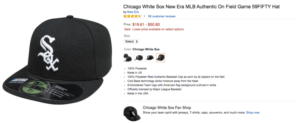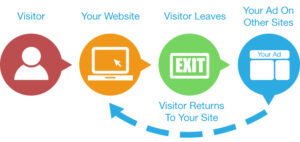Three Ways to Re-Introduce Products to Past Visitors
Tom Armitage
Seven touchpoints to close a sale, right? If that’s the case, you can’t expect that single tweet, that one video, or that lonely local TV commercial to do the trick to persuade them to make a purchase. It just ain’t gonna happen. You have to take the bull by the horns and get in front of your customers again. And again. And again. And again. You get the gist.
Remarketing and re-introduction tactics
 The internet is a beautiful thing. For one, you can re-emphasize your products and services and sell digitally at a much lower cost than before. Another is the ability to truly pinpoint your audience. Through filters and targeting options within advertising platforms, you no longer have to deal with the guesswork that was involved with billboards, TV and radio. Now, you can select gender, age, interest, location and much more and get in front of the personas that you know are interested in you.
The internet is a beautiful thing. For one, you can re-emphasize your products and services and sell digitally at a much lower cost than before. Another is the ability to truly pinpoint your audience. Through filters and targeting options within advertising platforms, you no longer have to deal with the guesswork that was involved with billboards, TV and radio. Now, you can select gender, age, interest, location and much more and get in front of the personas that you know are interested in you.
You aren’t going to make a sale on your first encounter with a customer. Consumers usually like to research and consider before purchasing. Even what we consider low-risk items, like food or household goods, often require awareness and consideration. Close your eyes and think about walking down the grocery store aisle. What makes you purchase one product over another? You’ve used it before and trust it? Your mom recommended it? You remember seeing an ad on TV or coupons in last Sunday’s newspaper?
There’s a number of reasons you might choose one over the other. But the bottom line is that you’ve seen or heard of the brand before. Now think about if the investment is much greater. Like a car at $27,000. A house at $250,000. Or maybe you are a purchasing manager for a large corporation and you are making a million dollar decision for new equipment within the company. Very rarely do we purchase a product or service on a whim without having built some sort of familiarity with it before. And the stronger the relationship, the easier it is to pull the trigger, especially for major purchases.
That’s why remarketing and re-introduction tactics are so important in the B2B marketing world.
And it’s not a once-and-done effort. You can’t do it in Q1 and think it’s done. It’s ongoing. Forever working. Always “on.” You need to stay top of mind and further educate potential customers on who you are and what you do. The buying cycle for your product/service could be a long time – 3 months? 6 months? 12 months? If so, you have some time on your hands to remind those folks about you and help persuade them to buy from you rather than a competitor. Okay, here’s a few ways that you can do this.
Google AdWords Remarketing
Have you ever gone shopping on Amazon and looked for, let’s say, a new baseball hat. You’re searching around and find one you like. A classic Chicago White Sox cap from 59FIFTY. You click on it to view more details.

You look at the images, select the size you want, and move to the checkout page to purchase. But then you get sidetracked. Your son calls you into the other room to help him with his math homework. You close down your browser and call it a night. Family comes first.
A few days later, you are browsing the web and you see an ad:
Don’t Forget About Your Hat!
Still interested in that 59FIFTY
cap? Complete your order today.
www.amazon.com
Holy cow?! How did they know I wanted a hat? Oh, that’s right, I was browsing the other day and I forgot to complete my transaction! You click on the ad, it brings you to the page you left off, and you complete the order. Go Sox!
Remarketing is an interesting tactic in the marketing world. Sites that use this tactic drop a cookie when your distinct IP address reaches a certain page on the site. Now they can remember who you are. Later, they then can serve you up with highly specific ads based on your browsing history. In the above example, Amazon is dropping the cookie on purchase level pages so if someone fails to complete their order, they can remind them and push them over the finish line.

It’s a genius tactic and one only warranted by the advent of the internet coupled with tracking software. If you are using Google AdWords for your PPC campaigns, you can do remarketing. Just follow the necessary prompts to get it set-up (it’s a bit more complex than just running basic search ads because you need to install additional code or new tags in Tag Manager). Once it is set-up, then create ads that are specific to the pages you’ve dropped the code. The more targeted the better. It’s a great tactic to remind past visitors of you and through Google’s Ad Network, you can reach the majority of your website visitors while they are browsing elsewhere on the net.
Social Media Remarketing
In a very similar way, you can retarget on social media sites too. So, instead of serving up ads on third party websites through the Google Network, ads will appear on Facebook or Twitter. By using software like AdRoll, you can drop the cookie and target the user’s IP address. But now, the next time they are on Facebook, they will see ads for your product or service. This can be in the right sidebar or as a promoted post. Twitter has a similar function where you can offer promoted tweets to people who have already visited your site.
 The selection might be dramatically smaller than what you are used to advertising among on Facebook and Twitter (your 1,000,000 pool might drop to just 1,500), but think about how much more relevant they are. They’ve already visited your site and have invested time and interest. Now, your ads do not have to be awareness-based, because they’re no longer in the first stage of the cycle. They’re beyond that. Research has begun. Now, you can emphasize your key messaging and work to get them to come back again, one step closer to the sale. Focus on consideration. Since we know that your consumers are apt to be visiting social media sites, this is another great touchpoint in the buying process.
The selection might be dramatically smaller than what you are used to advertising among on Facebook and Twitter (your 1,000,000 pool might drop to just 1,500), but think about how much more relevant they are. They’ve already visited your site and have invested time and interest. Now, your ads do not have to be awareness-based, because they’re no longer in the first stage of the cycle. They’re beyond that. Research has begun. Now, you can emphasize your key messaging and work to get them to come back again, one step closer to the sale. Focus on consideration. Since we know that your consumers are apt to be visiting social media sites, this is another great touchpoint in the buying process.
Lead Nurturing
I like to describe lead nurturing as advanced email marketing. Well, advanced, automated and much more strategic. Many companies participate in monthly e-newsletters to their loyal customer base. So watch how we take this many steps further. Like remarketing, this third tactic also relies on tracking user IP addresses to help understand who they are and how they behave on your website over time. Based on that behavior, you can then send specific email messages to further persuade them. The messages happen automatically by the actions they’ve taken on your site. Here is a scenario to help you understand better.
Greg Brady is a purchasing manager looking to buy a new piece of machinery from your industrial equipment dealership. He visits your website in early February as he starts his research. He gets busy with other projects and doesn’t come back to his search until March, now that his deadline is approaching. He’s in a rush now. He starts gathering information, downloading white papers, reading case studies. But he still isn’t ready to buy just yet, he wants to come back after the weekend. On his third visit, he’s ready to negotiate. He completes a form on your website and includes his contact information:
Greg Brady
Company XYZ
(315) 555-5555
gregbrady@xyz.com
He hits submit. And now the real magic begins.
His information is automatically entered into our lead nurturing software (think of software like Marketo, Hubspot or SharpSpring). The system will then understand the customer’s name (Greg Brady) and pair it with the IP address that he is using. Now, it looks back into that IP address’s history and we can see when Greg visited our site before. In this case, twice in March and once in February. We can see what pages he visited, how long he spent on those pages, what source/site he came from, and if he took any other actions on our site (clicked links, downloaded documents, watched vidoes, etc). We now have a better understanding of what he’s interested in.

We can take this one step further too. We can have his name automatically entered into our lead nurturing process for future communication. Perhaps that means he is automatically sent follow up emails through the software once a day, for the next three days. Or maybe he’ll be sent our latest case study on the equipment he was looking. Each message can be customized based on the actions he took, or the pages he visited.
Let’s say Greg filled out a form on our underground drilling product page. My subsequent emails would then be aligned with his needs and talk about our drill products and how we can help him make a decision on that product. If he takes another action on one of those emails, he will automatically be added to a different list – perhaps this one is the list my sales guy uses to follow up via phone call. The possibilities and the combinations of communication are endless. It’s all based on your particular company, your buying cycle, your customer needs, and the most strategic way to lead them towards a purchase.
The most important point here is that you can stay top of mind and continue to develop a relationship over time.
Think about how many people visit your site, leave, and now you’ve lost them forever. It doesn’t have to be that way. Lead nurturing should be a very important part of your digital marketing plan. Because if you have something meaningful to share with your audience, don’t limit that distribution. Let your loyal subscribers and past visitors in on it. And use those key messages to your advantage to further them down the funnel.
Interesting in remarketing or lead nurturing? I’d love to chat with you more. Learn more about our services here at Site-Seeker, or shoot us a note.